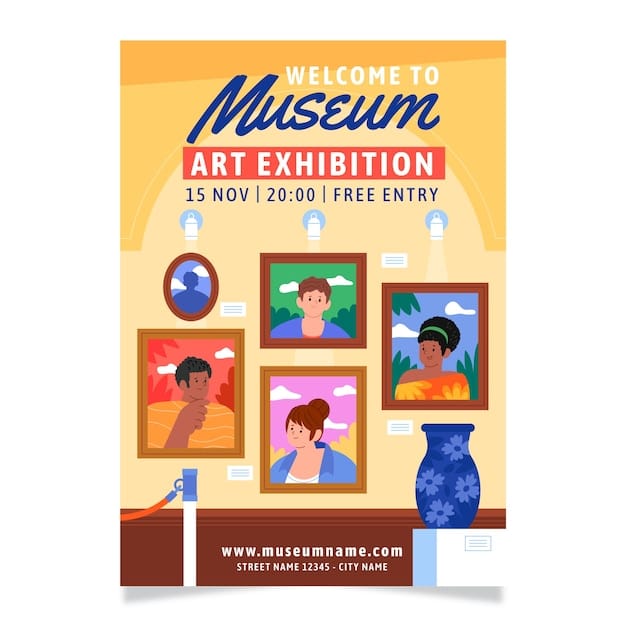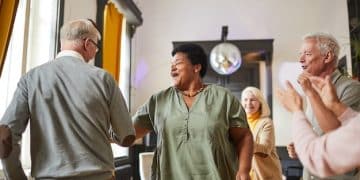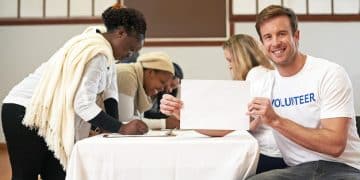How to Organize a Community Art Auction: A Step-by-Step Guide

Organizing a successful community art auction involves selecting a venue, soliciting art donations, creating marketing campaigns, managing logistics, and ensuring compliance with legal requirements, all while engaging the local arts community and fostering a vibrant atmosphere.
Are you looking to immerse yourself in the local arts scene while simultaneously supporting your community? Learn how to organize a successful community art auction: a step-by-step guide that will help you turn your vision into reality.
Planning Your Community Art Auction
Embarking on the journey of organizing a community art auction begins with laying down a solid foundation. This initial planning phase is crucial, setting the stage for a successful event that benefits both the artists and the community.
Let’s explore the critical aspects of planning, including defining the event’s purpose and setting clear, achievable goals.
Defining the Event’s Purpose
Before diving into the nitty-gritty details, it’s essential to clarify the purpose of your community art auction. What specific goals do you hope to achieve through this event?
Identifying the purpose early will guide your decisions and ensure that the auction aligns with your community’s needs and aspirations.
Setting Clear, Achievable Goals
With a clear purpose in mind, set specific, measurable, achievable, relevant, and time-bound (SMART) goals for your art auction. These goals will provide a roadmap for success and enable you to track your progress effectively.
- 📊 Determine the fundraising target: How much money do you realistically aim to raise through the auction?
- 🎨 Decide on the number of artists to involve: How many local artists will participate in the event?
- 🎟️ Set attendance goals: How many attendees do you anticipate drawing to the auction?
- 📣 Choose promotional strategies: What marketing channels will you use to reach your target audience?
Setting SMART goals will not only keep you focused but also provide tangible benchmarks to measure the success of your community art auction.
In conclusion, the initial planning phase is the cornerstone of a successful community art auction. By defining the event’s purpose and setting achievable goals, you’ll pave the way for a meaningful and impactful event that celebrates local art while supporting your community.
Securing a Venue and Setting the Date
Once you have a solid plan in place, the next crucial step is securing a suitable venue and setting the date for your community art auction. These two factors can significantly impact the event’s success.
Let’s explore the essential considerations for selecting the right venue and choosing a date that maximizes attendance and engagement.
Choosing the Right Venue
Selecting the right venue is paramount to creating a memorable and inviting experience for your attendees. Consider factors such as venue size, accessibility, ambiance, and available amenities.
Opt for a space that can comfortably accommodate your anticipated crowd while providing ample room for displaying artwork and facilitating bidding.
Selecting a Date That Maximizes Attendance
Choosing the date wisely can make or break your community art auction. Consider scheduling conflicts, local events, and seasonal factors that may impact attendance.
Aim for a date that offers maximum convenience for your target audience, ensuring strong turnout and enthusiastic participation.

- 📅 Avoid major holidays or popular local events: Choose a date that minimizes competition for attendees’ attention.
- ☀️ Consider seasonal factors: Opt for a time of year when weather conditions are favorable and outdoor activities are appealing.
- 📣 Promote the date well in advance: Give your target audience plenty of notice to mark their calendars and plan their schedules.
By carefully selecting both the venue and the date, you’ll enhance the overall experience for attendees and set the stage for a successful and well-attended community art auction.
In summary, securing the right venue and setting a strategic date are essential steps in organizing a community art auction that attracts a significant audience and leaves a lasting impression.
Soliciting Art Donations and Establishing a Theme
With the venue and date locked in, it’s time to focus on the heart of your community art auction: the artwork itself. Soliciting donations from local artists and establishing a theme can add creativity and coherence to the event.
Let’s delve into effective strategies for acquiring artwork and setting a thematic tone that resonates with your community.
Reaching Out to Local Artists
Building relationships with local artists is vital for securing art donations for your auction. Start by reaching out to artists whose work aligns with the event’s purpose and aesthetic.
Clearly communicate the auction’s goals, the benefits of participation, and how their contributions will support the community.
Deciding on a Theme or Focus
Adding a theme or focus to your community art auction can enhance its appeal and attract a wider audience. Consider themes that reflect local culture, history, or social issues.
A well-defined theme can create a cohesive and engaging experience for attendees, making the auction more memorable and impactful.
- 🎨 Consider local themes: Themes related to local landmarks, traditions, or historical events can resonate deeply with the community.
- 🌱 Reflect on social issues: Themes that address relevant social issues can spark meaningful conversations and inspire collective action.
- 🎭 Highlight artistic styles: Focusing on a specific artistic style, such as abstract expressionism or contemporary realism, can create a unique and focused event.
By soliciting art donations strategically and establishing a captivating theme, you’ll curate a collection of artwork that both celebrates local talent and engages the community in meaningful ways.
In essence, acquiring compelling art donations and setting a relevant theme are essential components of a successful community art auction that showcases local creativity and fosters community engagement.
Creating a Marketing and Promotion Plan
No matter how exceptional your artwork or venue may be, your community art auction won’t succeed without a robust marketing and promotion plan. Effective outreach is necessary to get the word out and attract attendees.
Explore strategies for generating buzz and ensuring that your event is on everyone’s radar within your community.
Utilizing Social Media
In today’s digital age, social media is a powerful tool for marketing your community art auction. Create engaging content, share artist spotlights, and promote event details across various platforms.
Use targeted advertising to reach potential attendees and generate excitement leading up to the event.
Engaging Local Media Outlets
Partnering with local media outlets can significantly amplify your marketing efforts. Reach out to newspapers, radio stations, and television channels to secure coverage for your community art auction.
Highlight the event’s purpose, the artists involved, and the impact it will have on the community.

- 📰 Issue press releases: Craft compelling press releases that highlight key event details and the auction’s community impact.
- 📻 Conduct interviews: Arrange interviews with local media personalities to discuss the auction and its significance.
- 📣 Collaborate with influencers: Partner with local influencers to promote the event to their followers and extend your reach.
By effectively leveraging social media and engaging local media outlets, you’ll create a buzz around your community art auction, attracting a wider audience and maximizing its visibility.
In summary, developing a comprehensive marketing and promotion plan is essential for ensuring that your community art auction reaches its full potential and leaves a lasting impact on the local arts scene.
Managing Logistics and Event Day Operations
With the marketing efforts underway, it’s time to shift focus to the logistical aspects of your community art auction. Smooth event day operations are crucial for ensuring a seamless and enjoyable experience for all attendees.
Let’s explore the key elements of managing logistics and executing a successful event day.
Setting Up Registration and Check-In
Efficient registration and check-in processes are essential for creating a positive first impression. Set up a well-organized registration area with clear signage and friendly staff to assist attendees.
Consider implementing an online registration system to streamline the process and reduce wait times.
Overseeing Bidding and Payment Procedures
Clear and transparent bidding and payment procedures are vital for ensuring a fair and efficient auction process. Provide attendees with bidding paddles and clear instructions on how to participate.
Offer multiple payment options, including cash, credit cards, and online payment platforms, to accommodate diverse preferences.
- 🧮 Train volunteers: Provide thorough training to volunteers who will assist with the auction process, ensuring they understand the bidding rules and payment procedures.
- 📝 Use clear signage: Display clear signage indicating bidding increments, payment options, and other relevant information.
- 💳 Offer secure payment methods: Ensure that all payment transactions are secure and protected, safeguarding attendees’ financial information.
- 🤝 Provide assistance: Have staff members readily available to assist attendees with any questions or concerns they may have during the bidding and payment process.
By managing logistics efficiently and overseeing event day operations with attention to detail, you’ll create a memorable and enjoyable experience for both artists and attendees alike.
In essence, smooth logistics and seamless event day operations are integral to the success of your community art auction, ensuring that everyone can focus on celebrating local creativity and supporting the arts community.
Post-Auction Follow-Up and Community Engagement
The community art auction doesn’t end when the last piece is sold. The post-auction phase is an opportunity to reinforce connections with artists, attendees, and sponsors, all while sustaining the event’s impact on the community.
Explore strategies for post-auction follow-up and maintaining the momentum generated by the event.
Thanking Participants and Sponsors
Expressing gratitude to participants and sponsors is essential for nurturing relationships and fostering goodwill. Send personalized thank-you notes to artists, volunteers, sponsors, and attendees, acknowledging their contributions to the auction’s success.
Consider hosting a post-auction reception to celebrate achievements and express appreciation in person.
Sharing Auction Results and Impact
Transparency is key to building trust and credibility within the community. Share the auction’s results, including the total amount raised, the number of attendees, and the impact the funds will have on beneficiaries.
Highlight specific initiatives or projects that will benefit from the auction proceeds, demonstrating the tangible impact of the event.
- 📊 Publish a post-auction report: Create a comprehensive report summarizing the auction’s key statistics, achievements, and outcomes.
- 📢 Share beneficiary stories: Highlight stories of individuals or organizations who will benefit from the auction proceeds, showcasing the positive impact of the event.
- 📣 Engage stakeholders: Regularly update stakeholders on the progress of initiatives funded by the auction, ensuring transparency and accountability.
By prioritizing post-auction follow-up and community engagement, you’ll solidify relationships, reinforce the auction’s impact, and build a foundation for future collaborations and events.
In summary, post-auction efforts are crucial for sustaining the momentum generated by your community art auction, strengthening connections within the community, and ensuring that the event’s impact is felt long after the final gavel falls.
| Key Point | Brief Description |
|---|---|
| 📅 Planning & Goals | Define purpose, set SMART goals (fundraising, artists, attendance). |
| 🖼️ Art Donations | Reach out to local artists, set a theme. |
| 📣 Marketing | Use social media, engage local media; promote event details. |
| 🤝 Follow-Up | Thank participants, share results & impact; build for future events. |
FAQ Section
▼
The first step is defining the purpose of your art auction. Clearly understanding your goals, whether fundraising, community engagement, or artist support, will guide all subsequent decisions.
▼
Reach out to artists personally, emphasizing the auction’s benefits for them and the community. Offer promotion, exposure, and the chance to support a good cause for higher participation.
▼
Utilize social media by posting engaging content, artist spotlights, and event details. Also, engage with local media outlets for broader publicity and encourage them to cover the event.
▼
Streamline registration and check-in, provide clear bidding and payment processes, and make sure staff is trained. Clear signage, secure payment options, and readily available staff are vital.
▼
Send thank-you notes to participants, volunteers and donors, and share results to build trust. Highlight the positive impact and outcomes of the event. Transparency will reinforce positive relationships.
Conclusion
Organizing a successful community art auction involves careful planning, strategic marketing, smooth logistics, and consistent engagement. By following these steps, you can host an event that celebrates local artists, supports your community, and leaves a lasting impression on all involved.





